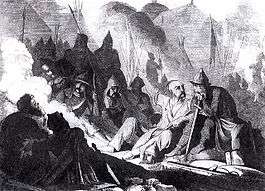Siege of Dorostolon
| Battle of Dorostolon | |||||||
|---|---|---|---|---|---|---|---|
| Part of the Rus'–Byzantine War of 970–971 | |||||||
| |||||||
| Belligerents | |||||||
| Byzantine Empire | Kievan Rus | ||||||
| Commanders and leaders | |||||||
| John I Tzimisces | Svyatoslav I of Kiev | ||||||
| Strength | |||||||
|
30,000 men[1] (possibly 40,000 men?)[2] 300 ships[2] |
50,000 men[3] (possibly 60,000 men?)[2] | ||||||
| Casualties and losses | |||||||
| Unknown, 350 killed in the last battle (Leo the Deacon). | 38,000, of which 15,000 killed in the last battle.[2] Calculated as the difference between the initial strength of Svyatoslav's army as reported by Leo the Deacon (60,000) and the number of Rus warriors receiving bread rations for their travel home after the truce (22,000). | ||||||

The Battle of Dorostolon was fought in 971 between the Byzantine Empire and forces of Kievan Rus. The Byzantines, led by John I Tzimisces, were victorious.
Background
During the course of the Rus'-Bulgarian war, Svyatoslav I of Kiev overran the eastern part of the First Bulgarian Empire and established his capital at Pereyaslavets on the Danube. Once John I usurped the throne, the Byzantines launched a counteroffensive. After they defeated the united Rus'-Bulgarian forces in the Battle of Arcadiopolis and recaptured Pereyaslavets, Svyatoslav was forced to flee to the northern fortress of Dorostolon (Drustur/Dorostorum).
Siege
Emperor John proceeded to lay siege to Dorostolon, which lasted for sixty five days. His army was reinforced by a fleet of 300 ships equipped with Greek fire.[2] There were several engagements before the walls of the city, which demonstrated to the Byzantines that the Rus' lacked skill in cavalry warfare. Among the casualties were the Emperor's relative, Ioannes Kourkouas (whose severed head was displayed by the Rus from one of the towers) and the second-in-command in Svyatoslav's army, a certain Ikmor (who was killed by Anemas, a son of the Cretan emir, in revenge for Ikmor's assassination of his father during the Byzantine siege of Crete).
The Rus' and their Bulgarian allies were reduced to extremities by famine. In order to appease their gods, they drowned chickens in the Danube, but the sacrifices failed to improve their position. As their hardships became intense, 2,000 Rus' warriors (including some women) sallied out at night, defeated a Byzantine force and went in search of supplies to the Danube; they later rejoined the besieged.
The Rus' felt they could not break the siege and agreed to sign a peace treaty with the Byzantine Empire, whereby they renounced their interests towards the Bulgarian lands and the city of Chersonesos in Crimea. Svyatoslav bitterly remarked that all his allies (Magyars, Pechenegs) betrayed him during this decisive moment. He was allowed to evacuate his army to Berezan Island, while the Byzantines entered Dorostolon and renamed it Theodoropolis, after the reigning empress Theodora.
Sources

The siege is described in detail by John Skylitzes and Leo the Deacon, although some of their assertions (e.g., Sveneld's death during the siege) appear to be apocryphal. Characteristically, Leo the Deacon attributes the victory to Saint Theodore Stratelates, who purportedly led the Byzantine army under the walls of Dorostolon.
References
Sources
- Andrey Nikolayevich Sakharov. Svyatoslav's Diplomacy. Moscow: Mezhdunarodnye otnosheniya, 1982.
- Fyodor Uspensky. The History of the Byzantine Empire, vol. 2. Moscow: Mysl, 1997.
- Haldon, John (2008). The Byzantine Wars. The History Press. ISBN 978-0-7524-4565-6.
- Treadgold, Warren (1997). A History of the Byzantine State and Society. Stanford University Press. ISBN 0-8047-2630-2.